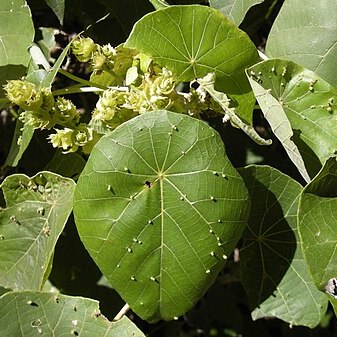Trees or shrubs, mostly dioecious (some forms of M. andamanica monoecious); indumentum usually of simple hairs and whitish to reddish glandular scales. Leaves alternate; stipules small or enlarged; petiole insertion often peltate; leaf blade undivided or lobed, base with glands, abaxially glandular-scaly; venation palmate or pinnate. Inflorescences axillary, sometimes at old leafless nodes, unbranched, branched, or females capitate or 1-flowered, unisexual, very rarely bisexual (M. andamanica); bracts sometimes with glands. Flowers 1 or few to many per bract. Male flowers: calyx closed in bud; sepals 2-4, valvate; petals absent; disk absent; stamens [1-]2-22[-30]; filaments free or shortly connate; anthers 3-or 4-locellate; pistillode absent. Female flowers: calyx cup-shaped or urceolate, apex denticulate or lobed, sometimes truncate, caducous or persistent; petals absent; disk absent; ovary 1-6-locular; styles simple, free, rarely shortly connate, stigmatic surface papillose. Fruit a capsule, (1 or)2-or 3(-6)-locular, smooth or spiny, often glandular scaly. Seeds subglobose, smooth.
Trees or shrubs, monoecious or dioecious. Indumentum multicellular, uniseriate or semi-stellate, non-glandular. Stipules persistent or caducous. Leaves alternate or opposite, petiolate, palminerved or penninerved, entire or dentate. Inflorescences axillary or terminal, racemose, paniculate, umbellate or cymose. Flowers unisexual, with only one perianth whorl, valvate or not. Male flowers pedicellate [sessile in M. polyadenia] in bracteate glomerules; pedicels 0.5–3 mm long; stamens 4–40; filaments arising vertically from a minute central disc; anthers dorsifixed, (2-or) 3 (or 4)-lobed, each deltate lobe opening from the point closest to the filament; pistillode absent. Female flowers single or paired, bracteate or ebracteate; subsessile to pedicellate; disc absent; ovary with connate bristles and trichomes present or absent; locules 2 (or 3), uniovulate; styles 1–3, filiform, united basally. Fruit an orbicular or bilobed sessile capsule, surface smooth or bristly, glabrous or pubescent, dehiscing vertically or horizontally.
Male flowers: calyx closed in bud, globose or clavate, later valvately 2–4-partite; petals and disk absent; stamens 2–5 or 10–20, filaments short, free or ± connate at the base, anthers small, terminal, apicifixed, (2)3–4-celled, (2)3–4-valved, transversely or cruciately dehiscent; pistillode absent.
Female flowers: calyx truncate or shallowly toothed, later becoming broadly cupular and splitting; petals and disk absent; ovary 1–3-celled, with 1 ovule per cell; styles 1–3, often rather stout, entire, free or connate at the base.
Inflorescences axillary or subterminal, racemose or paniculate, shortly pedunculate; bracts entire or lobed, glandular or not; male bracts many-flowered, female bracts usually 1-flowered; flowers shortly pedicellate or subsessile.
Leaves alternate, petiolate, stipulate, simple or lobed, entire or toothed, peltate or not, palminerved and/or penninerved, gland-dotted on lower surface.
Fruits not lobed, or less often 2–3-lobed, dehiscing into bivalved cocci or subindehiscent, smooth or verrucose, usually glandular.
Seeds ± globose; exotesta fleshy; endotesta crustaceous; albumen fleshy; cotyledons broad, flat.
Dioecious or rarely monoecious trees or shrubs, usually with a simple indumentum.

